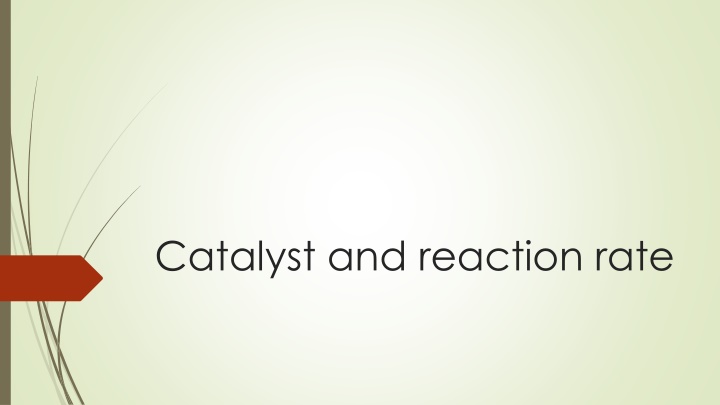
Understanding Catalysts and Chemical Reactions
Explore the role of catalysts in chemical reactions, how molecules need to collide with sufficient energy and proper orientation for reactions to occur, and the concept of activation energy. Discover how catalysts increase reaction rates by providing alternative pathways, all illustrated with insightful visuals.
Download Presentation

Please find below an Image/Link to download the presentation.
The content on the website is provided AS IS for your information and personal use only. It may not be sold, licensed, or shared on other websites without obtaining consent from the author. If you encounter any issues during the download, it is possible that the publisher has removed the file from their server.
You are allowed to download the files provided on this website for personal or commercial use, subject to the condition that they are used lawfully. All files are the property of their respective owners.
The content on the website is provided AS IS for your information and personal use only. It may not be sold, licensed, or shared on other websites without obtaining consent from the author.
E N D
Presentation Transcript
A chemical reaction involves a chemical change, which happens when two or more particles (which can be molecules, atoms or ions) interact. For example, when iron and oxygen react, they change to a new substance, iron oxide. Iron oxide has different chemical properties to iron and oxygen. This is different to a physical change. For example, water can turn to ice, but ice is still water in another physical state ice and water have the same chemical properties.
When chemicals react, particles need to collide with each with enough energy for a reaction to take place. The more often they collide, the more likely they are to react. Not all collisions result in reactions the reactants must be moving fast enough so that they collide with sufficient force for bonds to break. This minimum energy with which molecules must be moving in order for a collision to result in a chemical reaction is known as the activation energy. Even if two molecules collide with sufficient activation energy, there is no guarantee that the collision will be successful. In fact, the collision theory says that not every collision is successful, even if molecules are moving with enough energy. The reason for this is because molecules also need to collide with the right orientation, so that the proper atoms line up with one another, and bonds can break and re-form in the right order.
According to the collision theory, the following criteria must be met in order for a chemical reaction to occur: Molecules must collide with sufficient energy, known as the activation energy, so that chemical bonds can break. Molecules must collide with the proper orientation.
Catalyst Catalysts play an important part in many chemical processes. They increase the rate of reaction, are not consumed by the reaction and are only needed in very small amounts. Particles stick onto the surface of the catalyst (called adsorption) and then move around, so they are more likely to collide and react.
A catalyst is a substance that increases the rate of a chemical reaction by lowering the activation energy . Activation energy is the minimum amount of energy required for a chemical reaction to proceed in the forward direction. A catalyst increases the reaction rate by providing an alternative pathway or mechanism for the reaction to follow. https://www.youtube.com/watch?v=hd92QQeGVA
